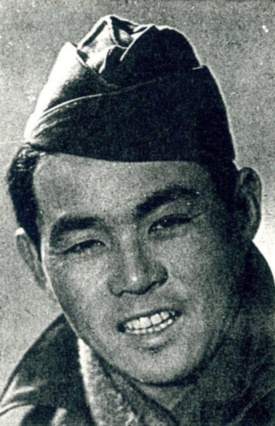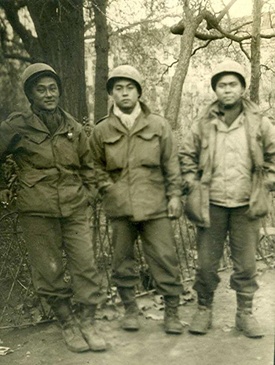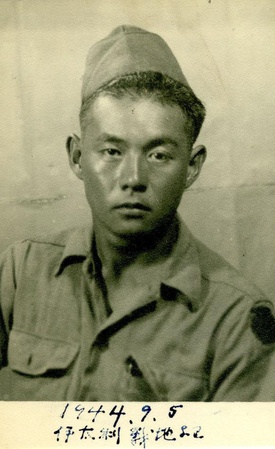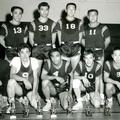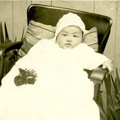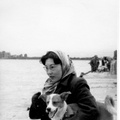When I was around 19- to 20-years old in 1959-60 during a family get together, I remember my Uncle Hiro telling me that he and his battery-mate Koji Konishi volunteered to be with an infantry company during the “Rescue of the Texas Lost Battalion” (rescue). This rescue is one of the U.S. Army’s most historic combat events. He told me it was a really frightening experience; and in saying so indicated to me that it wasn’t anything like being behind the infantry with his field artillery battery unit firing the 105-mm Howitzer cannon. I have always remembered what he said because I thought he wasn’t afraid of anything.
Koji and Hiro carried radio communication equipment in with the infantry company. He said that German artillery gunfire resulted in all kinds of shrapnel and tree fragments bursting everywhere. He was hit and thought he was wounded; so, called out to Koji to help him. Koji came over to check him out and told him that a bursting fragment, resulting from enemy artillery shelling which tore through his jacket, and he was okay. He also mentioned when the 100th Battalion/442 Regimental Combat Team (RCT) was sent back to Southern France for lighter combat duty, he saw himself in a newsreel about the rescue. This duty, after the rescue, is known as the “Champagne Campaign” taking place along and in the Mediterranean coastline area in the southeast corner of France known as the French Riviera.
At Hiro’s big surprise 70th birthday party in 1992, his close friend and battery-mate (Battery A), Joe Hattori, came up to the microphone to talk about Hiro during the rescue. In some detail, Joe told everyone the story of Hiro and Koji being with the infantry company and when Hiro thought he was hit and wounded. Joe, when starting to tell the story, asked Hiro what company he and Koji were assigned to, and Hiro said it was ”Company A.” Joe said that the men were crossing single file through a gullied area when the shelling from a German Tiger Tank’s 88 gun shattered a large tree nearby which was when Hiro received the bursting tree fragment passing through him and thinking he was wounded called out to Koji for help.
After Joe told the story, Hiro kiddingly said it was a “million dollar hit” and smiled about what happened so long, long ago. Koji, also with a smile on his face, acknowledged the story of what happened to Hiro. In reality, Hiro was very fortunate he wasn’t killed or wounded at that time. My wife Miyo videotaped Hiro's 70th birthday party, including the story told by Joe Hattori.
I recently read in the book Just Americans - How Japanese Americans Won a War at Home and Abroad by Robert Asahina that Company A was on the right flank during the rescue effort. When Major General Dahlquist was there on the front line, he directed the company to go forward on the right flank to ward off possible enemy counter attacks. Hiro told me about actually seeing Dahlquist during the rescue. General Dahlquist, a two-star general, was the Commander of the 36th Division. For the general to be right up on the front line during the rescue says how extremely important this effort was to the Army; and an Army news team was there to film it.
Thinking about what Hiro told me long ago about being in a theater and seeing himself in a newsreel about the “Rescue of the Lost Battalion,” I did a lot of on-line searching during the third week of November 2013 to find the U.S. Army newsreels about the rescue. I found the one official U.S. Army newsreel entitled ‘Lost Battalion’ Returns. This newsreel is now in public domain. In this newsreel, near the beginning, I'm sure I can recognize Hiro where he’s briefly shown talking on the walkie-talkie radio unit communicating with artillery support. He is holding a M1 carbine in his right hand. It's a very short, close-up film clip where the person is wearing his helmet and wool scarf around his neck and the right side of the lower face, nose/mouth/right cheek, is clearly seen. I thought that very likely this is Hiro. I stopped film movement taking a digital camera image of the person.
I then compared this, fairly clear, stopped image with photos of Hiro’s face taken in France two month later, and also an earlier photo of him taken in Italy in September 1944.
Hiro worked as a dispatcher in Manzanar, before he volunteered into the Army. Now, I’m pretty darn sure what he saw in the newsreel after Bruyeres/”Rescue of the Lost Battalion” is what can be seen in the now public domain newsreel. I carefully watched the whole newsreel many, many times. I didn’t see anyone else in it that looked like Hiro, except for that one clip. The mouth, nose, and side of face shown are surely that of Hiro. The film clip of who I think is Hiro is also in the DVD video 442 Live with Honor; Die with Dignity. Hiro once told me that he had a M1 carbine in the back of the seat of the Battery A deuce and half truck (2-1/2 ton truck) he drove. Hiro was a Tech 5, being a technical specialist corporal in rank.
On the way to an appointment in J-Town on Saturday, January 18, 2014, I told Miyo we should visit the Go For Broke Monument to talk to the 100th Battalion/442 RCT veterans who might be there as docents and maybe someone would know Uncle Hiro. When we got there, there were two docents: One an Italian American veteran of the Vietnam War named Rocco; the other a 442 RCT veteran of L Company named Hiro Nishikubo.
Rocco was kind enough to look up Uncle Hiro’s name on the monument and do a rubbing of Hiro’s name. Rocco mentioned to us that he was very proud to be a docent at the monument. What a wonderful thing to hear from this Vietnam veteran.
Hiro Nishikubo asked me the name of my relative who served in the 442. I told him “Hiroshi Ukita.” Boy, he got a smile on his face, saying that he used to golf with Uncle Hiro and Tachi all the time. Without me even mentioning Uncle Tachi’s name, he said Tachi right away. He also mentioned that he knew Koji Konishi, who was in Uncle Hiro’s battery.
It was absolutely amazing that on this day the docent on duty at the monument was Hiro Nishikubo. I just had some strong inner inkling/feeling that we needed to visit there on this day.
The following things are what Hiro Nishikubo told me:
Now that Don Seki has moved to Hawaii, there are only two veterans of the 100th Battalion/442 RCT active as docents at the monument. Hiro comes on Saturdays, and the other veteran comes one day during the week.
Hiro Nishikubo was in Infantry Company L of the 442 RCT. Looking in the book, Americans - The Story of the 442d Combat Team, he was a staff sergeant and received the Purple Heart and Combat Infantry Badge. He told me that he was a replacement (third replacement group from Camp Shelby) into Company L, after the “Rescue of the Lost Battalion.” The squad was down to two men (from a twelve man squad) when he became a member of Company L.
He said that Uncle Hiro told him that he wanted to do some real fighting. So, he volunteered to be an artillery observer with an infantry company. Uncle Hiro told him it only took one day with the infantry company when he started thinking, “What am I doing here!” Hiro Nishikubo was telling me Uncle Hiro’s and Koji Konishi’s experience being with Company A during the “Rescue of the Lost Battalion.”
Hiro Nishikubo is 92-years old going on 93 this year. He told me he was born in 1921 so he is a year older than Uncle Hiro. Hiro looks and sounds great for being almost 93-years old.
He remembered when Uncle Hiro had his first stroke and then recovered enough to get back on the golf course. Since there were two Hiros playing golf together, in order to keep the markers straight, his marker was “Fat Hiro” and Uncle Hiro’s was “Skinny Hiro.” Hiro said that he used to weigh 200 pounds. Now he is not that heavy and about 5 feet, 5-inches tall.
As we were leaving, he told me that he became very close to Uncle Hiro and considered him “as a brother.” He basically told me this to be relayed to the rest of the Ukita family.
So, that was absolutely an amazing, emotional, gift from God day, meeting Hiro Nishikubo who knew Uncle Hiro so very well, and had nothing but fond memories of Uncle Hiro. I hope Hiro Nishikubo stays well and healthy for many, many more years.
© 2014 Russell Tadao Ukita


